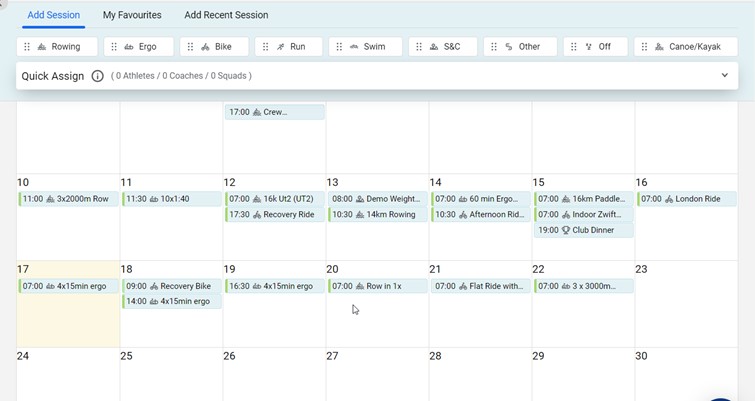Endurance training will help you to build stamina and through this type of training your body will gradually be able to withstand longer exercise routines. Lasting benefits include weight loss, increased strength, better health, and overall lifestyle improvement.
The best way to start with improving your capacity for endurance training is through a guided and data-backed training program.
From a health perspective, this type of training will help with cardiovascular endurance. Fitness-wise, it will increase muscular endurance. In this article, we will go through an extended list of endurance training plan benefits and look into two exercise paths you can choose to get where you need to be.
“Endurance training is an exercise focused on improving stamina, or the athlete’s ability to do something for a more extended period of time,” according to Paul Krebs, MD, of Premier Orthopedics, part of Premier Physician Network.
Examples of endurance training exercise
Endurance workouts or aerobic exercise will increase the rate and the depth of breathing and heart rate. This process will lead to more oxygen being absorbed in to your blood, and proportionately more carbon dioxide removed. The right endurance training exercises can help with circulatory system health and lung capacity, as well as decreasing the risk of several conditions, such as diabetes and cardiovascular diseases. Athletes can also increase their fitness level.
Usually, endurance exercise lasts around 60 minutes and takes place up to five days a week. It has to be aerobic training that uses major muscle groups repetitively. The following are the most common types of endurance training exercises:
Running
Running is amongst the most challenging exercises. Running can, of course, take place outdoors, or indeed indoors on a treadmill; indoors being slightly less effective, but still excellent for endurance training. Running is an exercise suitable for beginners and unavoidable for most athletes. Health benefits are countless, and depending on your level of fitness, you should look to incorporate the right mileage and pace of running into the endurance training program.
Walking
Walking is the simplest exercise and suitable for the broadest range of people. It’s an excellent choice for beginners and people with injuries & conditions such as joint problems. You can walk on the pavement, choose from thousands of trails, walk freely outdoors, or use a treadmill. Adjust the speed and duration of your walks to your individual fitness level.
Swimming
Swimming is on par with, or even slightly more intense than running. It has more prerequisites. You need to understand proper stroke and breathing techniques and have a swimming pool available, or another suitable body of water. It’s maybe not the best choice for endurance training newcomers or persons with heart issues.
Cycling
There are different levels of cycling, from high-intensity mountain routes to a stationary bike, which would be ideal for beginners that are trying to lose weight without stressing the ankles, hips, knees, or other body parts. Cycling is an excellent endurance exercise, and with the adequate program, you can gradually build up your stamina regardless of your starting fitness level.
Other possible classic training options could be jump rope, mountain climbers, jump squats, and of course, variations of these exercises. Also, there is an excellent selection of cardio machines like rowing machines, stepmills, air bikes, vertical climbers, stair-steppers, elliptical trainers and more.
Running for endurance vs HIIT for endurance
Running at a steady pace for around 60 minutes at 60-70% of the maximum capacity is a tested endurance exercise, beneficial for health & fitness. A newer alternative is High-Intensity Interval Training or ‘HIIT’.
In HIIT sessions, you alternate between short intervals of very high-intensity and slower intervals to recover. ‘High-intensity’ requires 9/10 on a perceived exertion scale for the intense part of the workout, meaning you sprint as hard as you can [if running].
With high-intensity interval training, your body will be in the anaerobic zone. This is because you’ll work at maximum intensity, meaning there won’t be enough oxygen. That is why the intense parts of exercise are short. In the resting section, your heart rate should drop to level 3 or 4 of perceived exertion. Depending on your fitness and goals, HIIT can last anywhere between 10 and 30 minutes.
Advantages of HIIT
Most exercises improve your metabolism, and HIIT goes that bit further. It requires large oxygen consumption in the intense cardio intervals, which translates into many benefits. The science behind HIIT suggests the anaerobic metabolism will use glucose to create energy. Without oxygen, lactic acid will pour into the muscles with its characteristic burn.
Burn more fat
With two metabolic processes, experts believe that the body goes through hormonal changes that burn fat with higher efficiency during and long after the workout is over.
Understanding a HIIT workout burns calories during the exercise, but it also creates an afterburn effect. The body is trying to recover from an intense workout, and in doing so, it consumes calories with post-exercise oxygen consumption.
Shorter workouts
With HIIT, you will work as hard as you can. HIIT workouts should be short as the body struggles to cope with long periods of intense interval work. If undertaking lengthier exercise, it is much wiser to employ steady-state cardio exercises since you’ll reap similar benefits.
Improved health
With HIIT, your body uses glucose as fuel for the muscles. This metabolic process will improve with high-intensity interval training as it will create a higher sensitivity in your body to insulin; effectively, you’ll need less insulin to lower glucose levels.
With high-intensity oxygen consumption, you’ll achieve the VO2 max and increase lung capacity. HIIT endurance training has a positive impact on blood pressure and cardiovascular health.
Disadvantages of HIIT
The words high-intensity suggest that HIIT is not suitable for everyone. It is not a recommended starting point for people that are not at a good level of fitness and stamina.
Higher risk of injury
If you regularly undertake steady-state cardio exercises and want to mix things up a little, you might wish to try HIIT. However, for beginners, high-intensity activities like jumps, sprints, high knees/kicks and others can lead to injuries. Though, you can get injured even if you are at a good fitness level; this is due to the sheer intensity of HIIT. It’s worth taking care whatever level you are on the fitness scale.
Could lead to overtraining
HIIT exercises are stressful on the body, and too much could lead to symptoms of burnout. If you experience a decrease in performance and after-effects like achiness, fatigue and even headaches, you may well have over trained. Unlike steady-state cardio, HIIT is not for everyday training. Limit your exercise to twice a week.
Less effective for the aerobic system
When you start with HIIT, initially you will see improved aerobic functions, but after some time you can see your aerobic fitness start to diminish. With only sticking with HIIT, you could develop great burst and strength, but not enough stamina.
Advantages of steady-state cardio
Running or other moderate steady-state cardio exercises have proven positive effects on cardiovascular endurance, weight loss, fitness level and both physical and mental health.
Faster recovery
Steady-state cardio is not as intense as HIIT. Walking, running, or cycling with lower (than HIIT, but not your lowest) intensity doesn’t stress your body as much. Usually, you can recover more quickly and repeat the workout the next day.
Increases slow-twitch muscle fibres
Slow-twitch muscle fibres use oxygen to generate more fuel and are suitable for continuous, extended exercise. With steady-state cardio you are training this part of your muscles which improves aerobic fitness and muscular endurance.
Burns calories and targets fat
Although steady-state cardio doesn’t equate to HIIT’s after-workout calorie consumption, this aerobic training will still help with weight loss at a steady pace. Since you can work out more frequently, the effects add up. Also, when working at a lower intensity, fat is the primary energy source.
Disadvantages of steady-state cardio
For some people, aerobic training can be tedious. With its repetitive nature, it’s not for everyone.
Risk of repetitive stress injuries
If you are completing the same exercise continuously over time, it might lead to injuries for parts of the body that are continuously under stress. There are typical injuries for runners, cyclists and other types of exercises that can be reduced in terms of their risk; thought you cannot completely remove all chances of injury.
More time needed
Unlike HIIT, where the training is less frequent and shorter, steady-state cardio is time-consuming, and you need to fit in more workouts (weekly) to achieve the desired result.
Can lead to weight loss plateau
Working out every day leads to an increase in fitness and stamina, but if you always repeat the same exercises, you could hit the wall so-to-speak. Your body will adapt to an exercise program and then lose fewer calories when you replicate the same exercises. This is why it is essential to mix things up a little.
With the above in mind, which method of exercise is then best for building endurance? It very much depends on the person and the goal of the workouts. If you want to succeed and get the best results, you’ll need to enjoy exercise routines. Steady-state cardio is an excellent way to build up your endurance and stamina and can be fun too! This type of continuous workout is irreplaceable if you are training for a half-marathon for example. It’s also suitable for beginners.
However, if you dislike running, or other repetitive longer exercises, you might want to go with HIIT. High-intensity will increase anaerobic and partially aerobic fitness. The importance of endurance training is the same for beginners, amateurs and professional athletes. In well-trained athletes, the use of HIIT workouts at 90-100% VO2 max could be the best way to improve aerobic fitness further.
For athletes, there are excellent tools that can help with choosing the best endurance training. Ludum’s training management and performance analysis tool has features that show statistics of ergo sessions and intensity zones. Data like heart rate charts and reviews of zones of exercise can help trainers plan for a better program. With metrics like endurance training score, TRIMP and Foster score (rating perceive effort for the duration of the session) you see a visual representation of the workouts through time and can make an informed data-based decision what type of training is best for you.
Benefits of Endurance Training
Regardless of the type of workout, endurance training benefits are numerous. With a suitable training program, you can secure multiple lifestyle, fitness and health gains. An improved physical look can also lead to a better self-image.
We will now look at why endurance training is so important.
Weight loss
Before tieing the laces on their sneakers, most people want to know if endurance training burns fat… The short answer is yes. Steady-state cardio such as running for 40 minutes a couple of times a week will burn calories at a steady pace. With five workouts weekly, this will cumulatively result in weight loss. Of course, exercise alone will not be sufficient to lose weight unless it’s supported with an appropriate diet plan however.
Improved fitness and agility levels
If you are wondering how to increase stamina, endurance training is an excellent way to do just that. If you are already working out with running routines, you can gradually train yourself to run longer distances. This process will build up your stamina. Endurance training is excellent for improved balance and coordination. Your fitness and agility are challenged during the training, so over time, you will improve in that segment. Being in better shape will also increase stamina for everyday activities. You will feel energised; which will only enhance your lifestyle.
Health benefits
Endurance training programs have a significant impact on health, from losing weight to improved cardiovascular stamina and health. Lesser-known benefits include osteoporosis prevention. When you train, the body releases more growth hormone, which in turn leads to improved bone density and strength. Along with enhanced bone quality from the inside, the muscle mass gives your skeleton better support.
Endurance training also helps with optimised immune system function. Surplus of proteins that are used for white blood cells and antibodies results in anti-inflammatory effects and an overall enhanced immune system.
Muscle growth
Muscle growth can be a benefit of workouts generally; which can lead to a more desired physique. The question is, though, does endurance training build muscle? Steady-state cardio builds up slow-twitch muscle fibre with long continuous workouts. Short sprints and other HIIT exercises help with fast-twitch muscle fibres growth. Straining your muscles stimulates the growth, and the same applies to endurance training.
An example endurance training program
Working out through a structured training program has multiple benefits compared with just performing random/sporadic training. If you go ahead without a training plan, you can potentially do more damage than actually benefitting from the exercise you’re getting through. Though, even if you don’t harm yourself with random workouts, you should consider a data-backed training program.
Through these plans, you will be able to track your progress and keep yourself motivated. With a well-constructed plan, you can reach training goals, make improvements and achieve strong advances in stamina, strength and fitness (overall) much easier.
Why are measuring improvements important?
By collecting data, you will know you are on the right track! With an extensive platform (such as Ludum), you can track performance in real-time. Monitor heart rate, intensity zones and fitness level progress all in one place on the dashboard.
Trainers or individual users can compare sessions with other weeks of a fitness program and draw data-backed conclusions, which can lead to improvements in the training program.
In one centralised location, you can add all the data that your team might be holding in ineffective spreadsheets; along with the advanced metrics like endurance training score, TRIMP score and Foster score. Both mobile and desktop versions have the training score widget for a quick overview.
Summary
Endurance training is equally essential for both amateurs and professional athletes. The goal of working out is to get in better shape, lose weight and improve your health. You can achieve all these benefits with a quality endurance training plan. For athletes, training is a necessity, and the goal is to grow with each training session.
If you want to measure individual/team performance effectively, why not register for a free trial with Ludum.
View more content like this

What Training are your Athletes Actually Doing?
Not only do the vast majority of coaches not know what the amount of training quality or volume each of their athletes has done, they
Who actually completed the Club Training Programme? Anybody?
Most coaches have no absolutely no insight into what training any given athlete has completed over a season. They could produce a copy of the
Benefits Of An Endurance Training Plan
Endurance training will help you to build stamina and through this type of training your body will gradually be able to withstand longer exercise routines.



